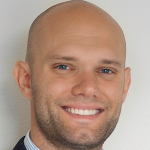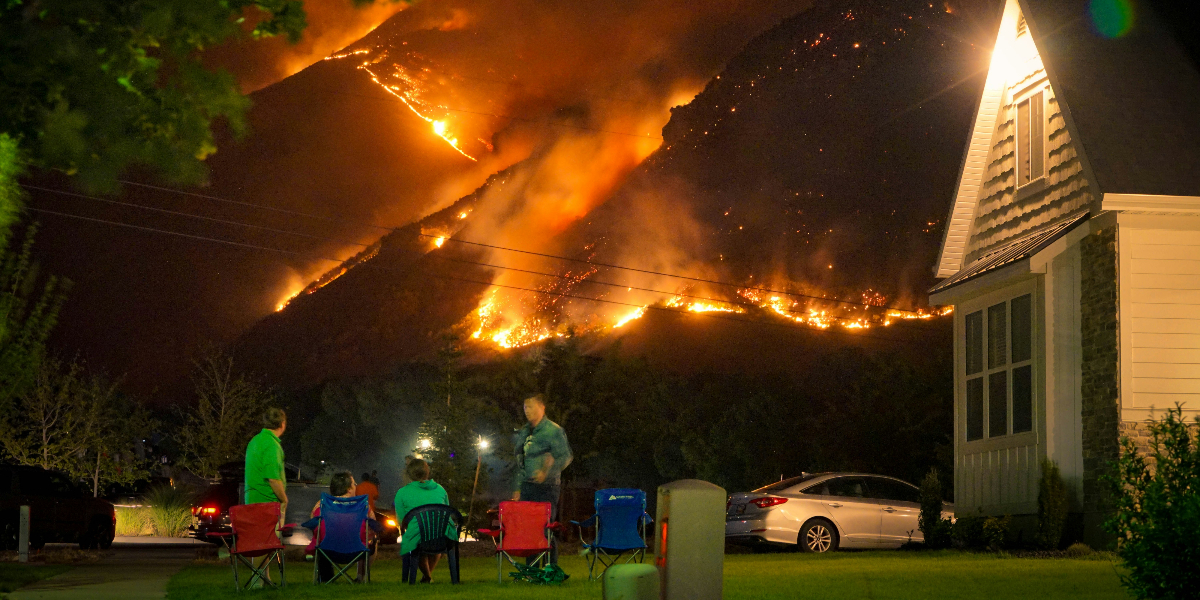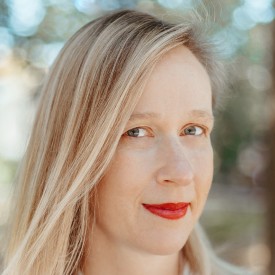Kate Marvel is a climate scientist and premier science communicator. As a former cosmologist, she received a PhD in theoretical physics from Cambridge University. She led the “Climate Trends” chapter in the U.S. Fifth National Climate Assessment, has given a TED Talk, appeared on Meet the Press and The Ezra Klein Show, and testified before the U.S. Congress. She has written for Scientific American, Nautilus magazine, and the On Being Project.
What’s the big idea?
For her work, Kate Marvel uses computer models of the Earth to study climate change. She can see the world end—in outlandish or realistic ways—by toying with these models. Scientific knowledge gains a lot of critical information from these digital experiments, but climate change is not happening in a computer. It’s happening in the real world, and it’s reasonable to have feelings about that, even as a scientist. Maybe especially as a scientist, who can see their dire predictions playing out in the world all their loved ones inhabit. Avoiding the emotions around climate change does not make scientists more credible because objectivity regarding our home planet is a lie. We all have conflict of interest about the Earth, and science supports our feelings.
Below, Kate shares five key insights from her new book, Human Nature: Nine Ways to Feel About Our Changing Planet. Listen to the audio version—read by Kate herself—below, or in the Next Big Idea App.

1. Wonder.
I started my career as a cosmologist, which means I studied the entire Universe. You should believe me when I tell you that the only good part of it is the Earth. We live on an absolutely perfect planet, and we understand so much about it. We take an understanding of its physics and write it down in equations and translate it to code—that’s a climate model.
We’ve been able to create these tiny digital planets to play with because we understand the physics. We understand how the Earth receives its energy from the sun and radiates it back into space. We know that if there were no atmosphere, the planet would be well below freezing and couldn’t support life as we know it.
But a tiny fraction of the atmosphere (less than one half of one percent) is made up of heat-trapping greenhouse gases. They’re powerful enough to raise the temperature to 60 degrees Fahrenheit. We know this, which means we know what happens when more greenhouse gases are added to the atmosphere. Even though the predictions may be dire, we should never lose sight of how amazing it is that we know anything at all.
2. Anger.
None of this is new science. We have understood the basics of the greenhouse effect since the 1800s. We’ve known the world is warming for decades. But the history of climate science is intertwined with the history of climate denial.
“They knew, and they lied.”
Scientists learn new things, and others lie about those results. In a leaked memo, the oil giant Exxon laid out its strategy: emphasize the uncertainty. Yes, scientists don’t know everything. There is plenty to learn about our changing planet, but there is no doubt that the world is warming and human actions are responsible. The very early climate models were shockingly accurate at predicting what we have seen happen.
The most accurate one? Developed by Exxon. They knew, and they lied. It’s ok to be mad about that.
3. Fear.
The Earth is now about 1.4 degrees Celsius hotter than it was before the Industrial Revolution. This doesn’t seem like a very big number, but as the Earth heats up, things change in scary ways.
Heat waves get more frequent and more extreme. Warmer air is thirstier air, which dries out the soil and leads to drought. Warm air holds more water vapor, which means we also expect heavier downpours and increased flood risk. Warm water is hurricane food, so we expect stronger storms. Rising seas mean higher storm surges. All of this is very frightening.
Climate change is happening to us in the world we make for it. It is making unequal conditions even more unequal and exposing cracks in society. Historically, periods of natural climate change have led to social upheaval. It’s probably not a coincidence that when the weather got weird during the so-called Little Ice Age in Europe, the number of women accused of witchcraft shot up. So even though I’m frightened of rising seas and extreme weather, the scariest thing about climate change is what it will make us do to each other.
4. Pride.
Human beings are not a very humble species. Right now, we’re considering so-called solutions to climate change that can only be called hubris. Instead of reducing greenhouse gas emissions, maybe we could cool the planet by spraying particles high in the atmosphere to block the sun. This isn’t as far-fetched as it sounds.
“We’re considering so-called solutions to climate change that can only be called hubris.”
Volcanic eruptions periodically inject so much gas, dust, and ash into the stratosphere that they cool the entire planet. After the eruption of Mount Tambora, the year 1816 was known as “the year without a summer.” The more recent eruption of Mount Pinatubo in 1991 cooled the Earth by about half a degree Celsius. Instead of waiting for an eruption, we could be the volcano.
The science is fairly solid that this would work, if “work” means cool the planet. But you can’t cancel greenhouse gas warming by blocking the sun. We know there would be consequences for things like the water cycle. And there’s a lot we don’t know about how such deliberate geoengineering would work. We would be better off working to reduce greenhouse gas emissions to zero. That would be something to be proud of.
5. Hope.
The most frequently asked question that all scientists get: Is there any hope? But I think this is the wrong question. No one asks whether you hope you can clean the bathroom. Just clean the bathroom!
To stop the planet warming, we need to build out renewable energy and transmission lines. Stop heating and cooking with dirty fuels. Learn how to manufacture things without spewing carbon dioxide. Replace gasoline cars with electric vehicles, public transportation, and walkable cities. Steward our land more wisely and eat fewer cows. Build, stop, learn, replace, steward—so many verbs, and none of them are “hope.”
But if you need hope, know that human beings have done wonderful things before. We used to kill tens of thousands of whales every year. Now, most countries have banned whaling. Our air used to be so filthy that millions of people got sick and died early. Now, we’ve passed clean air legislation and breathe more freely. There was a hole in the ozone layer. The international community fixed the problem, and now it’s getting smaller. Yes, to stop climate change, we must do something no one has ever done before. But this is what happens in any story worth telling.
Enjoy our full library of Book Bites—read by the authors!—in the Next Big Idea App:






























